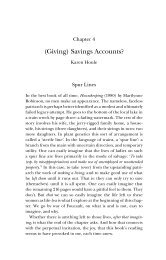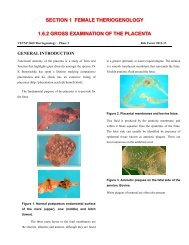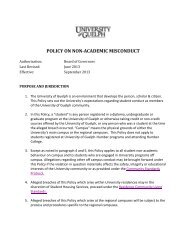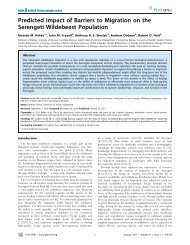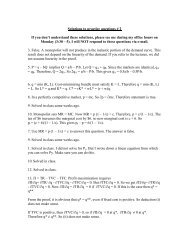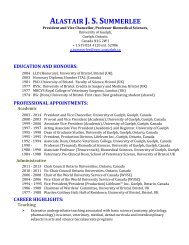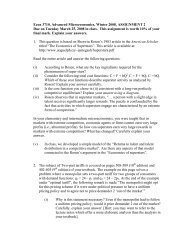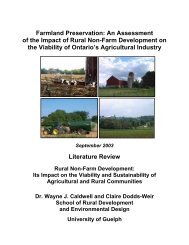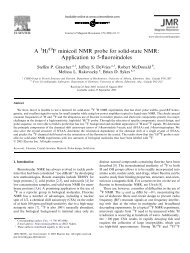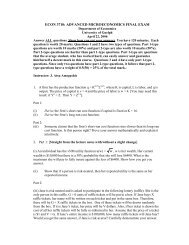The biology of Canadian weeds. 117. Taraxacum officinale G. H. ...
The biology of Canadian weeds. 117. Taraxacum officinale G. H. ...
The biology of Canadian weeds. 117. Taraxacum officinale G. H. ...
You also want an ePaper? Increase the reach of your titles
YUMPU automatically turns print PDFs into web optimized ePapers that Google loves.
ties <strong>of</strong> 2,4-D are thought to cause the major herbicidal<br />
effects, including cell elongation, epinasty and hypertrophy,<br />
but the precise mode <strong>of</strong> action <strong>of</strong> 2,4-D is still unknown<br />
(Sterling and Hall 1997). <strong>The</strong> selectivity <strong>of</strong> 2,4-D toward<br />
dicotyledonous plants is based on differences in plant morphology,<br />
and the rate <strong>of</strong> herbicide translocation and metabolism<br />
between mono- and dicotyledonous plants (Hagin<br />
et al. 1970; Devine et al. 1993).<br />
In creeping red fescue grown for seed in Alberta, various<br />
mixtures <strong>of</strong> herbicides were used to control T. <strong>of</strong>ficinale<br />
(Darwent and Lefkovitch 1995). In 94–100% <strong>of</strong> trials,<br />
greater than 80% control (percent reduction in biomass) <strong>of</strong><br />
T. <strong>of</strong>ficinale was achieved by applying metsulfuron at 4.5 g<br />
ha –1 , either alone or in combination with each <strong>of</strong> the<br />
graminicides sethoxydim (at 500 g ha –1 ) or fluazifop-P<br />
(at 250 g ha –1 ). A combination treatment <strong>of</strong> dicamba (at<br />
280 g ha –1 ) and 2,4-D (at 560 g ha –1 ) provided greater than<br />
80% control <strong>of</strong> T. <strong>of</strong>ficinale in only 25% <strong>of</strong> trials. However,<br />
tank-mixing sethoxydim (at 500 g ha –1 ) or fluazifop-P (at<br />
250 g ha –1 ) improved the efficacy <strong>of</strong> the dicamba/2,4-D<br />
combination, resulting in greater than 80% control <strong>of</strong> T.<br />
<strong>of</strong>ficinale in 62% and 71% <strong>of</strong> trials, respectively (Darwent<br />
and Lefkovitch 1995). <strong>The</strong> enhanced control from the addition<br />
<strong>of</strong> the graminicides to the dicamba plus 2,4-D combination<br />
is probably due to the effect <strong>of</strong> surfactants that were<br />
added to the tank-mix.<br />
Several herbicides are effective at controlling T. <strong>of</strong>ficinale<br />
in alfalfa or other forage legumes, yet they are not<br />
registered or recommended in Canada. Moyer et al.<br />
(1990) reported that annual applications <strong>of</strong> hexazinone<br />
(1.0 kg ha –1 ) and chlorsulfuron (0.01 kg ha –1 ) maintained<br />
almost complete control <strong>of</strong> T. <strong>of</strong>ficinale in alfalfa (Medicago<br />
sativa L.) and sainfoin (Onobrychis viciaefolia Scop.)<br />
in Alberta, where control was measured as the reduction<br />
in dry matter yield. In a study in Saskatchewan<br />
by Waddington (1980), the herbicides dichlobenil, terbacil,<br />
and simazine were each applied annually over 3 or 4 yr<br />
for control <strong>of</strong> T. <strong>of</strong>ficinale. Dichlobenil applied at<br />
2.2 kg ha –1 resulted in 100% reduction in the T. <strong>of</strong>ficinale<br />
population by spring <strong>of</strong> the fifth growing season. Similarly,<br />
terbacil applied at 1.1 kg ha –1 resulted in 96% reduction<br />
in the T. <strong>of</strong>ficinale population by the spring <strong>of</strong> the fifth<br />
year. However, simazine was less effective when applied<br />
at 0.8 kg ha –1 and 1.7 kg ha –1 and resulted in only 37 and<br />
71% reduction <strong>of</strong> T. <strong>of</strong>ficinale, respectively. A US study<br />
investigated the efficacy <strong>of</strong> buthidazole, metribuzin,<br />
simazine and 2,4-DB at various rates for the control <strong>of</strong> T.<br />
<strong>of</strong>ficinale (Sheaffer and Wyse 1982). Most herbicides temporarily<br />
reduced T. <strong>of</strong>ficinale populations, but only buthidazole<br />
continued to reduce populations in the year following<br />
application. However, control <strong>of</strong> T. <strong>of</strong>ficinale did not consistently<br />
increase alfalfa yield, and so the use <strong>of</strong> herbicides<br />
to control T. <strong>of</strong>ficinale in alfalfa cannot be recommended<br />
(Sheaffer and Wyse 1982).<br />
In other <strong>Canadian</strong> studies, T. <strong>of</strong>ficinale plants were tolerant<br />
to ethalfluralin applied at 1.1 kg a.i. ha –1 and incorporated<br />
into the soil prior to planting T. <strong>of</strong>ficinale as a crop for<br />
salad use in Québec (Michaud et al. 1993). Paraquat did not<br />
control T. <strong>of</strong>ficinale during fallow in the southern <strong>Canadian</strong><br />
STEWART-WADE ET AL — TARAXACUM OFFICINALE G. H. WEBER EX WIGGERS 839<br />
prairies because it has only contact action and will not affect<br />
the root (Blackshaw and Lindwall 1995).<br />
Maleic hydrazide has been used to control T. <strong>of</strong>ficinale in<br />
apple orchards in the USA. Plant numbers were reduced<br />
from 5.1–10.1 individuals m –2 in control plots to 2.6 individuals<br />
m –2 when maleic hydrazide was applied at a rate <strong>of</strong><br />
6.7 kg ha –1 . Similar results were found for both spring and<br />
fall applications <strong>of</strong> the herbicide (Miller and Eldridge 1989).<br />
Mowing just before treatment with maleic hydrazide may<br />
have decreased T. <strong>of</strong>ficinale control (Miller and Eldridge<br />
1989). In another US study, <strong>Taraxacum</strong> <strong>of</strong>ficinale was controlled<br />
by quinclorac at 0.84 kg ha –1 and by a combination<br />
<strong>of</strong> clopyralid plus triclopyr at 0.16 kg ha –1 plus 0.47 kg ha –1<br />
respectively (Neal 1990).<br />
In a study in Virginia, USA, Chandran et al. (1998) found<br />
that a spring application <strong>of</strong> isoxaben at a rate <strong>of</strong> 0.56 kg ha –1<br />
in turfgrass caused 100% control <strong>of</strong> T. <strong>of</strong>ficinale 1 mo after<br />
application, where control was measured as emergence<br />
compared to untreated plots. However, control <strong>of</strong> T. <strong>of</strong>ficinale<br />
dropped to 62%, 1 yr after application. A fall application<br />
<strong>of</strong> isoxaben at 0.56 kg ha –1 resulted in 83% control <strong>of</strong><br />
T. <strong>of</strong>ficinale after 1 yr. Results were similar for isoxaben<br />
applied at 0.84 kg ha –1 or 1.12 kg ha –1 . Control <strong>of</strong> T. <strong>of</strong>ficinale<br />
in plots that received both spring and fall applications<br />
<strong>of</strong> isoxaben was similar to control <strong>of</strong> T. <strong>of</strong>ficinale in plots<br />
receiving only fall applications. A spring application <strong>of</strong> oxadiazon<br />
at 3.36 kg ha –1 resulted in 100% control <strong>of</strong> T. <strong>of</strong>ficinale<br />
1 mo later, but after 1 yr, T. <strong>of</strong>ficinale abundance was<br />
greater in these treated plots than in untreated plots. <strong>The</strong><br />
findings for fall applications <strong>of</strong> oxadizaon at this rate were<br />
similar, revealing that oxadiazon only provides short-term<br />
control <strong>of</strong> T. <strong>of</strong>ficinale (Chandran et al. 1998).<br />
Other chemicals have also been tested for their herbicidal<br />
efficacy on T. <strong>of</strong>ficinale. In laboratory experiments in the<br />
USA, allelopathic saponins from the roots <strong>of</strong> alfalfa had little<br />
effect on the germination <strong>of</strong> seeds or the growth <strong>of</strong><br />
seedlings <strong>of</strong> T. <strong>of</strong>ficinale (Waller et al. 1993). <strong>The</strong> herbicidal<br />
efficacy <strong>of</strong> corn gluten meal, a waste product from corn<br />
milling, has been tested on T. <strong>of</strong>ficinale and other <strong>weeds</strong><br />
(Quarles 1999). When applied at 324 g m –2 in greenhouse<br />
pot tests, corn gluten meal reduced survival <strong>of</strong> T. <strong>of</strong>ficinale<br />
by more than 75% by inhibiting root formation during germination.<br />
Under field conditions, corn gluten meal reduced<br />
the T. <strong>of</strong>ficinale population by about 90%, which was probably<br />
due to the combination <strong>of</strong> root inhibition and competition<br />
from Kentucky bluegrass (Quarles 1999).<br />
12. Response to Other Human Manipulations<br />
Integrated pest management strategies for T. <strong>of</strong>ficinale in<br />
turf include the selection <strong>of</strong> competitive turfgrass species,<br />
application <strong>of</strong> increased quantities <strong>of</strong> fertilizers, and<br />
mechanical control by mowing or removal. For example,<br />
studies in Ontario showed that Kentucky bluegrass was the<br />
least competitive <strong>of</strong> six turf species, perennial ryegrass was<br />
the most competitive and increased amounts <strong>of</strong> nitrogen fertilizer<br />
suppressed T. <strong>of</strong>ficinale in all turfgrass swards (Hall<br />
et al. 1992; Tripp 1997). Grass competition under frequent<br />
close mowing did not prevent T. <strong>of</strong>ficinale from surviving<br />
and spreading (Timmons 1950). Of four grasses tested,



